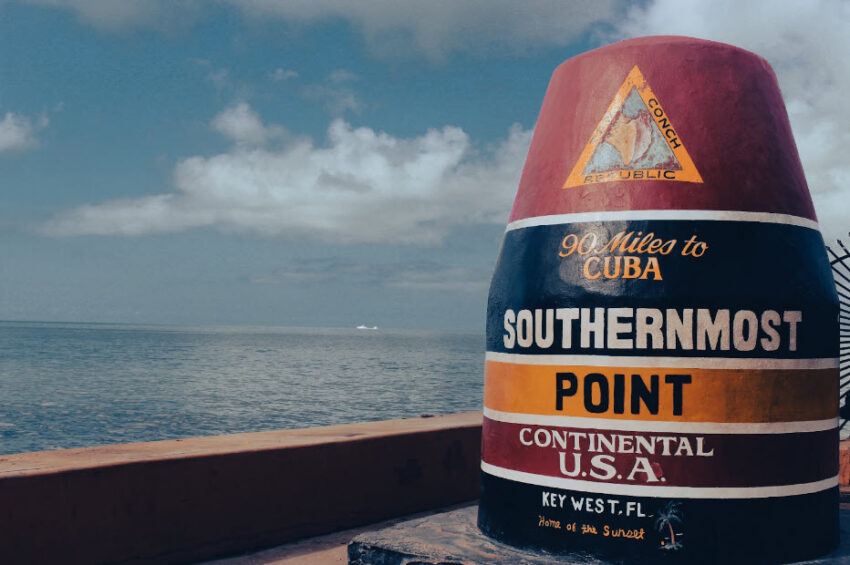Located at the very end of Florida, Key West is one of the most significant tropical destinations in the continental United States. Known for its vibrant nightlife and the iconic buoy, Key West is also home to a variety of fascinating animals. During your visit, you can expect to encounter a wide range of critters, including iguanas and various aquatic creatures in the nearby waters. This article will explore three animals found in the region, all coincidentally beginning with the letter ‘C’.
The History of Ernest Hemingway and His Cats
Even when discussing six-toed domesticated felines, Ernest Hemingway’s name remains unforgettable through books and films. Hemingway moved to Key West in 1931, and his presence left a lasting impression on the city during his 11-year residency. He frequented local bars and enjoyed fishing, developing a fondness for the lighthouse next to his home, which became his guide back. Key West served as the backdrop for his book “To Have and To Have Not.” Following his suicide in 1961, his house transformed into the Ernest Hemingway Museum, where visitors can learn about his life while being surrounded by cats.
Polydactyl cats, known for their extra toes, were among Hemingway’s beloved pets. While not all descendants inherit polydactylism, Hemingway’s cats started multiplying after he acquired his first one. Today, approximately 60 cats at the museum bear names of celebrities or well-known characters, such as Billie Holiday, Snow White, and Joe DiMaggio, keeping Hemingway’s legacy alive.
At The Ernest Hemingway Home and Museum, visitors can view his personal belongings, including his typewriter. The museum also features Hemingway’s pool, which sparked a quarrel with his then-wife and resulted in a penny embedded in the concrete. The estate’s gardens enhance its tropical charm, showcasing a variety of plants like palmettos and mangroves. This attraction appeals to a wide range of visitors, from Hemingway enthusiasts to cat lovers and those seeking beautiful tropical scenery.
The History of Dry Tortugas and Cletus the Crocodile
Although not within Key West’s city limits, Dry Tortugas is an extraordinary state park worth visiting while in the southernmost point of the United States. Discovered in the early 1500s by Ponce De Leon, the Dry Tortugas islands became home to Fort Jefferson on Garden Key. Initially utilized by the United States military for monitoring passing boats during wars, the fort later served as a prison. However, the park’s remote location presented challenges for soldiers and prisoners alike, as adverse weather conditions affected Fort Jefferson’s structure, and diseases claimed many lives. Abandoned since at least 1900, Fort Jefferson is now a major attraction of Dry Tortugas National Park, offering excellent snorkeling opportunities nearby. Visitors can explore the fort, hike around the island, and access the park by boat or aircraft. Opting for the full-day plane package provides more time to enjoy the park compared to traveling by boat. Garden Key offers some of the most breathtaking views in the Key West area.
While crocodiles are not typically found in the ocean, they have surprisingly been spotted on the Dry Tortugas islands and even at Fort Jefferson. The most recent documented crocodile was Cletus, nicknamed “The Loneliest Crocodile,” due to the remote location of Garden Key. Cletus resided near Fort Jefferson for many years, but as the area became more popular for snorkeling and hiking, it posed significant risks. In 2017, Cletus was relocated from Dry Tortugas after spending 14 years there. He now enjoys the company of other crocodiles in the Everglades. Since his departure, no further reports of crocodile sightings have been recorded on the Dry Tortugas islands.
The Key West Chickens and Their Origin
In addition to tropical tunes, the sound of squawking and crowing chickens is commonplace in Key West. While these birds did not originate from the area, some were brought to Key West in the 1800s from nearby Caribbean islands. Others are former pets that have become feral. Although these chickens have a long history as residents, they are not universally adored in Key West. Some consider them a disturbance similar to invasive and damaging iguanas. However, many locals used to regularly feed the chickens until a new law enacted in 2021 put an end to the practice. These birds hold a significant legacy in the city, and it is hoped they will continue to thrive for many years to come.
Whether you are vacationing or residing in Key West, encountering animals is inevitable. Exploring the city, visiting Hemingway’s cats, and the possibility of spotting a crocodile ensures that you will find something cuddly (or not!) to keep you company. Regardless of your personal preferences, the animals residing in the Conch Republic contribute to its unique charm.
Sources:
- https://www.nps.gov/drto/planyourvisit/guidedtours.htm
- https://www.wlrn.org/environment/2014-11-13/miles-off-key-west-roams-the-loneliest-american-crocodile
- https://www.ernesthemingwaycollection.com/about-hemingway/ernest-hemingway-in-key-west
- https://www.hemingwayhome.com/our-cats
- https://davesgarden.com/guides/articles/view/1917
- https://www.floridawildvethospital.com/polydactyl-cats-an-amazing-genetic-mutation/
- https://www.nps.gov/drto/planyourvisit/guidedtours.htm
- https://www.nps.gov/drto/planyourvisit/garden-key.htm
- https://www.athomekeywest.com/blog/local-legends-key-west-gypsy-chickens
- https://www.nps.gov/drto/learn/nature/crocodile.htm#:~:text=For%20nearly%2014%20years%2C%20one,not%20heavily%20used%20by%20visitors.
- https://www.nps.gov/drto/learn/historyculture/index.htm#:~:text=Fort%20Jefferson%2C%20the%20largest%20all,the%20Civil%20War%20delayed%20construction.


Great article Madison, the way you describe key west makes me want to start packing my bags and go see this place tomorrow! Thanks for the info.
This article gave me so much imformation about the Keys and Dry Tortugas well written.